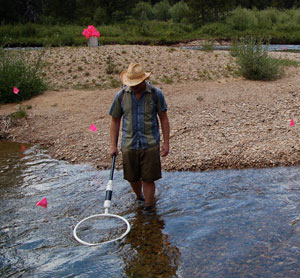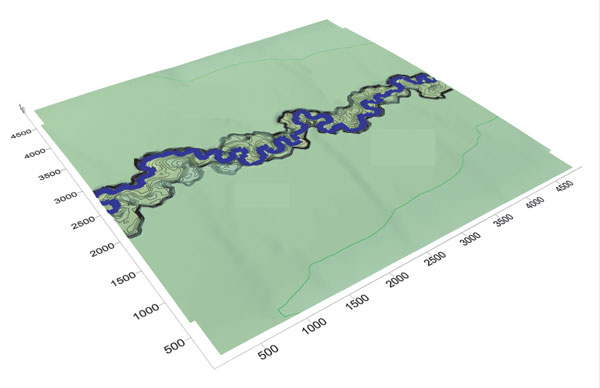 |

|
| Tucker Group Home | People | Research | Publications | Courses | Software | Contact Us |
| RESEARCH GROUPS @ CIRES > |
Position of tracer rocks in Halfmoon Creek through time (from Bradley and Tucker, in prep.)
Nate Bradley hunts rocks
Stream meander simulation used to study floodplain residence time distributions (model from Clevis et al., 2006) |
Sediment dispersion and fractional calculus projectA Random Walker's View of Sediment Motion and DispersionDuring the height of the Manhattan Project, unknown quantities of plutonium were thrown into desert washes around Los Alamos. The plutonium, adhered onto sediment grains, began moving downstream, eventually making its way to the Rio Grande River. This is just one of many examples of the process of sediment dispersion. When sediment grains move down a river or hillslope or coastline, they spread apart. The speed with which they move, and the rate at which they spread, has important theoretical and practical implications. How fast will a plume of contaminated sediment move? How will its concentration change over time and space? How much time will sediment grains spend in active transport, where they are subject to abrasion and bombarded by cosmogenic radiation? How much time do they spend stored, where they can weather and weaken? Amazingly, there is little theory or data available to answer these questions. Hence, there is a great opportunity to improve our state of knowledge. Field data using various environmental tracers – radio-tagged cobbles, tagged sand or silt grains, etc. – can reveal patterns of transport and spread in different environment, while experimental facilities provide a window into dispersion at the grain-motion level. New mathematical and numerical techniques provide the tools to interpret data. Some first steps on this path are discussed by Bradley et al. (2010) and Tucker and Bradley (2010). FundingInitial work on this project was supported by the U.S. Army Research Office (EV-47033) and by a CIRES Innovative Research grant. PublicationsBradley, D.N., Tucker, G.E., and Benson, D. (2010) Fractional dispersion in a sand-bed river: Journal of Geophysical Research, v. 115, F00A09, doi:10.1029/2009JF001268. Tucker, G.E., and Bradley, D.N. (2010) Trouble with diffusion: reassessing hillslope erosion laws with a particle-based model: Journal of Geophysical Research, v. 115, F00A10, doi:10.1029/2009JF001264.
|



